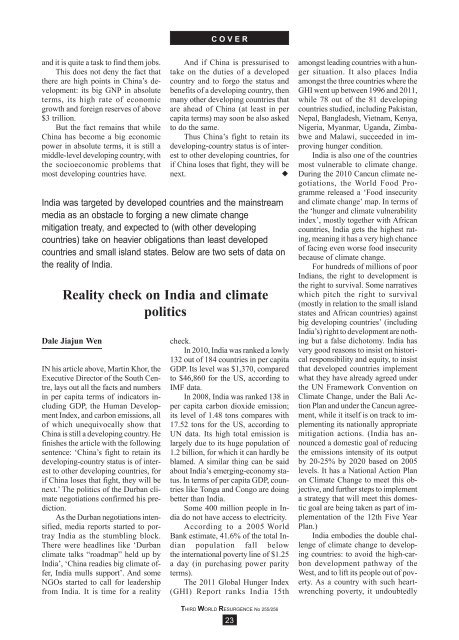Download - Third World Network
Download - Third World Network
Download - Third World Network
Create successful ePaper yourself
Turn your PDF publications into a flip-book with our unique Google optimized e-Paper software.
C O V E Rand it is quite a task to find them jobs.This does not deny the fact thatthere are high points in China’s development:its big GNP in absoluteterms, its high rate of economicgrowth and foreign reserves of above$3 trillion.But the fact remains that whileChina has become a big economicpower in absolute terms, it is still amiddle-level developing country, withthe socioeconomic problems thatmost developing countries have.India was targeted by developed countries and the mainstreammedia as an obstacle to forging a new climate changemitigation treaty, and expected to (with other developingcountries) take on heavier obligations than least developedcountries and small island states. Below are two sets of data onthe reality of India.Reality check on India and climatepoliticsDale Jiajun WenIN his article above, Martin Khor, theExecutive Director of the South Centre,lays out all the facts and numbersin per capita terms of indicators includingGDP, the Human DevelopmentIndex, and carbon emissions, allof which unequivocally show thatChina is still a developing country. Hefinishes the article with the followingsentence: ‘China’s fight to retain itsdeveloping-country status is of interestto other developing countries, forif China loses that fight, they will benext.’ The politics of the Durban climatenegotiations confirmed his prediction.As the Durban negotiations intensified,media reports started to portrayIndia as the stumbling block.There were headlines like ‘Durbanclimate talks “roadmap” held up byIndia’, ‘China readies big climate offer,India mulls support’. And someNGOs started to call for leadershipfrom India. It is time for a realityAnd if China is pressurised totake on the duties of a developedcountry and to forgo the status andbenefits of a developing country, thenmany other developing countries thatare ahead of China (at least in percapita terms) may soon be also askedto do the same.Thus China’s fight to retain itsdeveloping-country status is of interestto other developing countries, forif China loses that fight, they will benext.ÿucheck.In 2010, India was ranked a lowly132 out of 184 countries in per capitaGDP. Its level was $1,370, comparedto $46,860 for the US, according toIMF data.In 2008, India was ranked 138 inper capita carbon dioxide emission;its level of 1.48 tons compares with17.52 tons for the US, according toUN data. Its high total emission islargely due to its huge population of1.2 billion, for which it can hardly beblamed. A similar thing can be saidabout India’s emerging-economy status.In terms of per capita GDP, countrieslike Tonga and Congo are doingbetter than India.Some 400 million people in Indiado not have access to electricity.According to a 2005 <strong>World</strong>Bank estimate, 41.6% of the total Indianpopulation fall belowthe international poverty line of $1.25a day (in purchasing power parityterms).The 2011 Global Hunger Index(GHI) Report ranks India 15thamongst leading countries with a hungersituation. It also places Indiaamongst the three countries where theGHI went up between 1996 and 2011,while 78 out of the 81 developingcountries studied, including Pakistan,Nepal, Bangladesh, Vietnam, Kenya,Nigeria, Myanmar, Uganda, Zimbabweand Malawi, succeeded in improvinghunger condition.India is also one of the countriesmost vulnerable to climate change.During the 2010 Cancun climate negotiations,the <strong>World</strong> Food Programmereleased a ‘Food insecurityand climate change’ map. In terms ofthe ‘hunger and climate vulnerabilityindex’, mostly together with Africancountries, India gets the highest rating,meaning it has a very high chanceof facing even worse food insecuritybecause of climate change.For hundreds of millions of poorIndians, the right to development isthe right to survival. Some narrativeswhich pitch the right to survival(mostly in relation to the small islandstates and African countries) againstbig developing countries’ (includingIndia’s) right to development are nothingbut a false dichotomy. India hasvery good reasons to insist on historicalresponsibility and equity, to insistthat developed countries implementwhat they have already agreed underthe UN Framework Convention onClimate Change, under the Bali ActionPlan and under the Cancun agreement,while it itself is on track to implementingits nationally appropriatemitigation actions. (India has announceda domestic goal of reducingthe emissions intensity of its outputby 20-25% by 2020 based on 2005levels. It has a National Action Planon Climate Change to meet this objective,and further steps to implementa strategy that will meet this domesticgoal are being taken as part of implementationof the 12th Five YearPlan.)India embodies the double challengeof climate change to developingcountries: to avoid the high-carbondevelopment pathway of theWest, and to lift its people out of poverty.As a country with such heartwrenchingpoverty, it undoubtedlyTHIRD WORLD RESURGENCE No 255/25623















